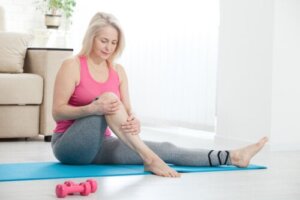6 Questions to Ask before Exercising if You Have Arthritis


Reviewed and approved by the nurse Leidy Mora Molina
When we suffer from pain, the most common thing to do is to avoid exercise or training, especially if the joints are involved. However, perhaps the best option is to do the opposite, although we must take the necessary precautions. Read on to find out the 6 questions you should answer before exercising if you have arthritis.
Arthritis is the inflammation of one or more joints that causes pain, stiffness, or swelling, and usually decreases our range of motion. Today, there are many treatments to help you cope better, but there is still no definitive cure.
Doing physical activity safely can help improve mobility and reduce pain.
If you have arthritis, it’s important to exercise. It will help you control your discomfort, achieve greater flexibility, and improve joint function.
In other words, it will improve your quality of life. However, you must take into account several factors before you start training. For that reason, we propose you these 6 questions to consider before exercising with arthritis.
1. What type of arthritis do you have?
There are more than 100 rheumatic diseases included in the category of “arthritis.” Osteoarthritis is the most common.
Others, such as rheumatoid arthritis, lupus, and gout are also among the most common. A visit to the doctor will be necessary to be able to determine which is the affliction that you suffer from and, consequently, to elaborate your training plan accordingly.
For example, if you suffer from rheumatoid arthritis, which is an inflammatory affliction, flexibility exercises can be a good option. In the case of osteoarthritis, you have to keep in mind that using heavy weights can aggravate the condition and generate more pain, so low-impact exercises are the best option.
According to a 2004 study, it was concluded that the combination of modest weight loss plus moderate exercise in the medium term provides overall improvements in function, pain, and mobility performance in overweight older adults with osteoarthritis of the knee.

2. What is the level of pain in the affected areas?
Physical activity can help reduce pain, but we must take into account which exercises are suitable according to our physical condition. If we suffer from pain, we should set limits, since we shouldn’t suffer when we exercise, but be able to perform it in an enjoyable and controlled way.
If the pain increases during the activity, you should stop and consult a doctor.
In 2021 a study was carried out on the efficacy of strength exercises in the treatment of rheumatoid arthritis. It consisted of a meta-analysis with 512 patients in a resistance exercise group and 498 patients in another control group. The results showed that, compared to the control group, strength exercise significantly decreased the disease activity score in patients.
3. How would you rate your current physical condition?
If you haven’t exercised for some time, it’s best to start slowly and intensify your activity gradually, especially if the reason for the abandonment was due to arthritis or some other condition.
You should be aware that the results will be seen in the medium and long term. Keeping joints moving and muscles strong helps to reduce pain or prevent further damage.
We think you may also enjoy reading this article: How Can You Improve the Symptoms of Osteoarthritis?
4. What happens if I don’t do physical activity?
If you don’t do any activity, your joints may become stiffer. In addition, the pain may increase.
The best thing to do is to exercise to strengthen your muscles. Otherwise, the body will become weak and will become more prone to suffer various types of injuries.
Like this article? You may also like to read: 5 Healing Juices for Rheumatoid Arthritis Pain Relief
5. What exercises should I do to treat arthritis?
You must always take into account the type of arthritis you suffer from in order to develop an appropriate training plan. Therefore, it’s essential to consult a specialist.
In general, the main exercises should have the following characteristics:
- Range of motion: This serves to reduce stiffness and make joints more flexible. This is beneficial in attenuating pain. These exercises are usually performed in the warm-up or stretching stage and include head rolls, shoulder movements, wrist rotations, and finger stretches, among others.
- Strengthening: These exercises seek to increase muscle strength, which helps to protect the joints. We must be careful with the weight we use, whoever. It’s always advisable to start light and increase progressively.
- Endurance: aerobic exercise strengthens the heart. Activities such as walking, cycling or some underwater exercises require little effort and contribute to increase the heart rate and work the muscles.
- Flexibility exercises combine movement, breathing, and meditation. They can be yoga, pilates, or other workouts of these characteristics that will allow us to achieve greater range of motion and help us to clear our minds.
- Isometric: These are resistance exercises in which there’s no movement, but the muscles are tensed and the posture is maintained for a stipulated time. Work is done with the body’s own weight. You can perform planks, hip lifts, strides, or static crunches, among other exercises.

6. Should I go to the doctor?
Of course you should! We recommend you go to a physiotherapist, who specializes in assessing the condition and develop treatment for those who suffer from conditions that limit the ability to move, either by injury or disease. The specialist can guide you on what you can do to improve and what to avoid to avoid aggravating your symptoms.
Get moving with exercise for arthritis and forget the pain!
Exercise is a great idea if you suffer from arthritis or even other conditions. On the one hand, it will help to improve your physical condition, strengthen your muscles, achieve more flexibility, and reduce pain. On the other hand, it will also improve your self-esteem, since you will feel better, will be able to cope well with daily activities better, and it will help you to recover those you may have abandoned.
Remember to consult your physiotherapist to develop the appropriate program according to the type of arthritis and your physical condition. Get moving and get rid of the pain!
All cited sources were thoroughly reviewed by our team to ensure their quality, reliability, currency, and validity. The bibliography of this article was considered reliable and of academic or scientific accuracy.
- Wen Z, Chai Y. Effectiveness of resistance exercises in the treatment of rheumatoid arthritis: A meta-analysis. Medicine (Baltimore). 2021 Apr 2;100(13):e25019. doi: 10.1097/MD.0000000000025019. PMID: 33787585; PMCID: PMC8021371. Disponible en: https://pubmed.ncbi.nlm.nih.gov/33787585/
-
Messier SP, Loeser RF, Miller GD, Morgan TM, Rejeski WJ, Sevick MA, Ettinger WH Jr, Pahor M, Williamson JD. Exercise and dietary weight loss in overweight and obese older adults with knee osteoarthritis: the Arthritis, Diet, and Activity Promotion Trial. Arthritis Rheum. 2004 May;50(5):1501-10. doi: 10.1002/art.20256. PMID: 15146420. Disponible en: https://pubmed.ncbi.nlm.nih.gov/15146420/
This text is provided for informational purposes only and does not replace consultation with a professional. If in doubt, consult your specialist.








